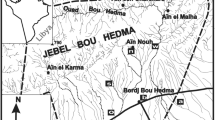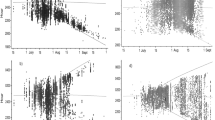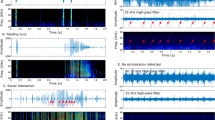Abstract
Most studies on the insect catching behavior in bats describe either echolocation behavior or capture techniques and flight behavior. Only in a few laboratory studies have both behaviors been studied simultaneously. We were able to do this in the field following the development of a battery operated 6 flash strobe system, which could be synchronized with the sound recordings. This equipment is still very bulky and cannot be moved during a recording session. Therefore we concentrated our efforts on a bat species, which reliably hunted in one area and could therefore be easily photographed. In the village Gornije Okrug near Trogir in Yugoslavia we found a site where several Pipistrellus kuhli regularly hunted for insects near a street light. The data from 10 nights of recording are presented here.
Access this chapter
Tax calculation will be finalised at checkout
Purchases are for personal use only
Preview
Unable to display preview. Download preview PDF.
Similar content being viewed by others
References
Cahiander, D.A., McCue, J.J.G., Webster, F.A., 1964, The determination of distance by echolocating bats. Nature 201: 544–546.
Griffin, D.R., Webster, F.A., Michael, C.R., 1960, The echolocation of flying insects by bats. Anim.Behay. 8: 141–154.
Grinnel, A.D., Hagiwara, S., 1972, Adaptations of the auditory nervous system for echolocation studies of New Guinea bats. Z.vergl. Physiol. 76: 41–81.
Schnitzler, H.-U., Menne, D., Kober, R., and Heblich, K., 1983, The acoustical image of fluttering insects in echolocating bats, in: Neurophysiology and behavioral physiology, F. Huber, and H. Markl, eds., Springer, Berlin Heidelberg New York.
Author information
Authors and Affiliations
Editor information
Editors and Affiliations
Rights and permissions
Copyright information
© 1988 Plenum Press, New York
About this chapter
Cite this chapter
Schnitzler, HU., Kalko, E., Miller, L., Surlykke, A. (1988). How the Bat, Pipistrellus Kuhli, Hunts for Insects. In: Nachtigall, P.E., Moore, P.W.B. (eds) Animal Sonar. NATO ASI Science, vol 156. Springer, Boston, MA. https://doi.org/10.1007/978-1-4684-7493-0_64
Download citation
DOI: https://doi.org/10.1007/978-1-4684-7493-0_64
Publisher Name: Springer, Boston, MA
Print ISBN: 978-1-4684-7495-4
Online ISBN: 978-1-4684-7493-0
eBook Packages: Springer Book Archive




